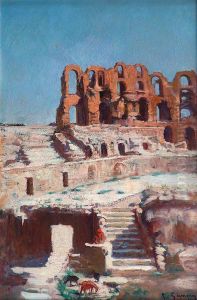Charles-Alphonse Gumery Paintings
Charles-Alphonse Gumery was a French sculptor born on June 14, 1827, in Villette, Paris. He is known for his works in the academic style, which were popular during the Second French Empire. Gumery was a student of the esteemed sculptor Armand Toussaint at the École des Beaux-Arts in Paris, which was the premier fine arts school in France. His education there provided him with a solid foundation in the classical traditions of sculpture, which he later adapted with his own creative flair.
Gumery began to gain recognition in the 1850s and 1860s, a period when the Beaux-Arts style dominated French art. He exhibited at the Paris Salon, the official art exhibition of the Académie des Beaux-Arts in Paris, and won several medals for his works, including a second-class medal in 1857 and a first-class medal in 1859. These accolades helped to cement his reputation as a skilled sculptor.
One of Gumery's most famous works is the gilded bronze figure 'L'Harmonie' (Harmony), which adorned the Palais Garnier, the opera house in Paris. Unfortunately, his original sculpture was destroyed in a fire in 1871, but it was later replaced by a copy. Gumery's other notable works include the statue of 'Adam Mickiewicz' on the poet's monument in Paris, as well as decorations for the Louvre and the Hôtel de Ville.
Gumery's career was cut short when he died during the Franco-Prussian War. The exact circumstances of his death remain unclear, but he passed away on January 19, 1871, in Paris, at the relatively young age of 43. Despite his untimely death, Gumery's work remains an important part of the artistic heritage of the Second French Empire, and his sculptures can still be seen in various public spaces and museums in France.
